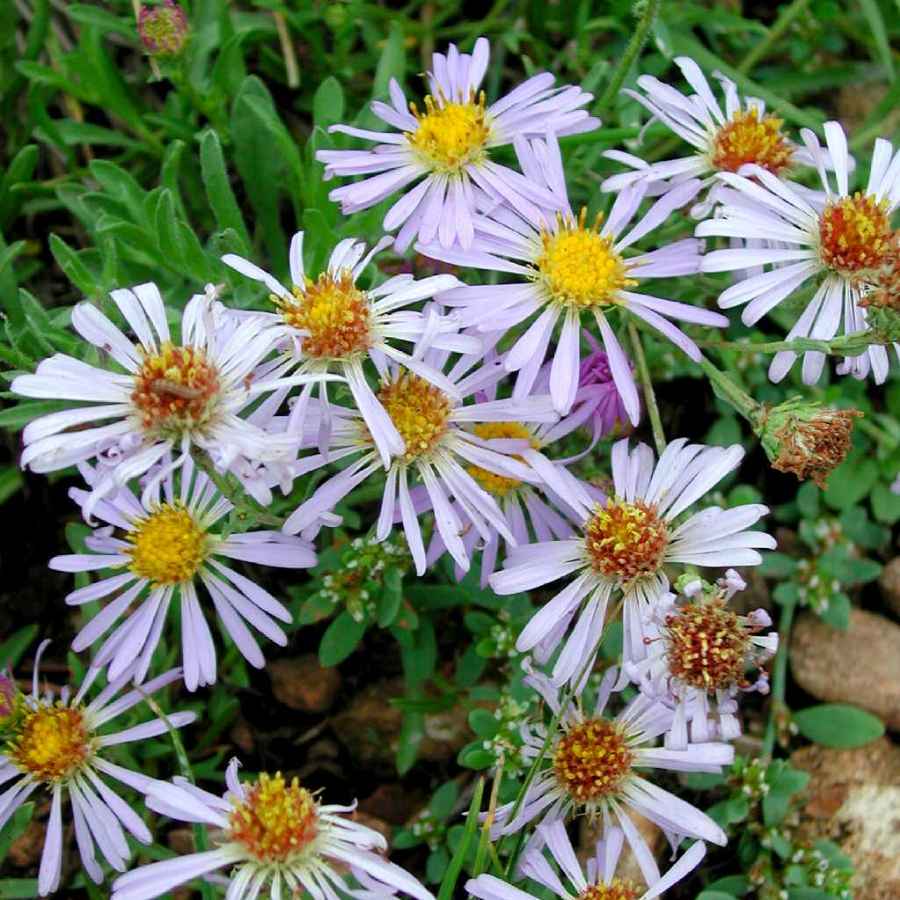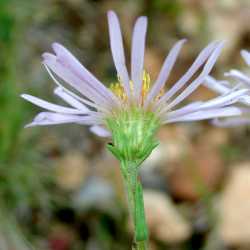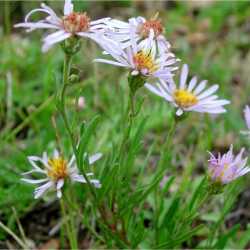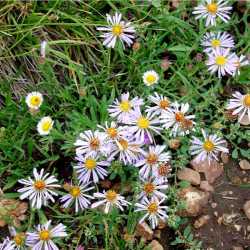Perennials 20-60 cm, colonial; long-rhizomatous. Stems 1-5+, ascending to erect, densely and uniformly strigose, especially distally. Leaves (grayish green) thin to firm, margins entire, apices acute, faces glabrous or strigose; basal usually persistent, petiolate, blades oblanceolate, 50-150 × 5-12(-15) mm, bases attenuate or cuneate, margins entire, apices usually acute; proximal cauline sessile or subpetiolate, blades oblong to narrowly obovate, 50-120 × 5-12 mm, bases attenuate or cuneate; distal sessile, blades 30-70 × 4-10 mm, reduced distally, bases cuneate to ± rounded. Heads in paniculiform arrays, branches ascending. Peduncles moderately to densely strigose, bracts 1-4, linear to oblanceolate. Involucres campanulate, 4-7 mm. Phyllaries in 3-5 series, narrowly oblanceolate or linear (outer) to linear (inner), unequal, bases indurate, margins entire, green zones obovate to elliptic, apices obtuse, faces densely strigose. Ray florets (10-)15-40; corollas violet, laminae 8-13 × 1-1.5 mm. Disc florets 25-65(-80); corollas yellow, sometimes purple-tinged, 4-6 mm, lobes triangular, 0.4-0.8 mm. Cypselae brown, cylindric to obovoid, not compressed, 2-3.5 mm, 3-5-nerved, faces hairy; pappi whitish, 4-7 mm. 2n = 26, 36, 52.
Flowering Jul-Aug. Meadows, grasslands, damp areas in sagebrush steppe and Ponderosa pine woodlands; 500-3200 m; Alta., B.C., Sask.; Ariz., Calif., Colo., Idaho, Mont., Nev., N.Mex., N.Dak., Oreg., Utah, Wash., Wyo.
Symphyotrichum ascendens is widely distributed in the Great Basin. It is an allopolyploid derived from the hybrid between S. spathulatum (x = 8) and S. falcatum (x = 5). Chromosome numbers differ markedly in their geographic distribution, 2n = 26 prevailing in the southwestern part of the range, and 2n = 52 in the northeastern part (G. A. Allen 1985) Backcrosses to both parental species or hybrids with related taxa are sometimes seen where the ranges overlap.
Duration: Perennial
Nativity: Native
Lifeform: Forb/Herb
General: Herbaceous perennials, to 80 cm tall, ascending to erect, herbage uniformly and densely strigose, plants colonial, with long rhizomes.
Leaves: Alternate, cauline leaves sessile, linear to lanceolate, to 12 cm long, margins entire, glabrate to densely pubescent, reduced distally, basal leaves elliptic to oblanceolate, petioled, persistent.
Flowers: Heads radiate, rays white, pink, blue, or violet, 15-40, 6-10 mm long, disk flowers yellow, sometimes purple-tinged, with triangular corollas, involucres campanulate, 4-7 mm high, graduated, phyllaries overlapping in 3-5 series, densely strigose with squarrose, herbaceous tips, heads few to many in racemes, panicles, or cymes, occasionally solitary.
Fruits: Achenes brown, cylindric to obovoid, not compressed, 2-3.5 mm, 3-5-nerved, pubescent. Pappus of whitish sub-equal capillary bristles, 4-7 mm.
Ecology: Found open coniferous forests, mountian meadows, grasslands, damp areas in sagebrush steppe and Ponderosa pine woodlands, from 1,500-10,500 ft (457-3200 m); flowering July-September.
Distribution: Saskatchewan to Washington, south to Colorado and northern Arizona.
Notes: Good characters for this species are the narrow, pubescent leaves and the phyllaries with squarrose, herbaceous tips.
Ethnobotany: Unknown
Etymology: Symphyotrichum comes from Greek symphysis for borne together and trichnos for hair, while ascendens means ascending.
Synonyms: Aster ascendens, Aster chilensis subsp. ascendens
Editor: LCrumbacher 2011








